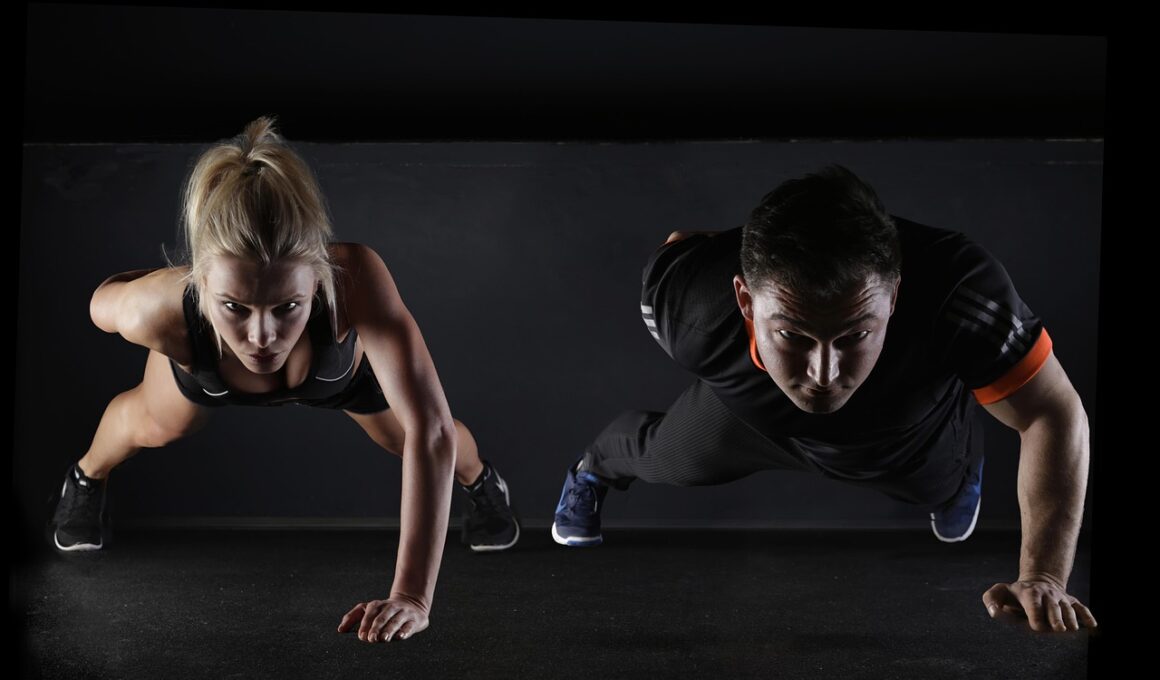The Science Behind Bodyweight Training and Muscle Growth
Bodyweight training is a form of exercise that utilizes your body weight as resistance. This method can lead to significant muscle growth and increased functional fitness. One of the primary benefits of bodyweight exercises is their ability to engage multiple muscle groups simultaneously. For beginners, they serve as an excellent starting point, minimizing the risk of injury while maximizing results. Advanced athletes can utilize bodyweight transitions to challenge their physical limits more effectively. Consistency in bodyweight training can lead to improved strength, balance, and flexibility, which are essential for overall fitness. Engaging in exercises like push-ups, pull-ups, and squats requires core stabilization, enhancing muscle recruitment throughout the body. Additionally, research shows that varying intensity during workouts facilitates muscle hypertrophy, making it pivotal to incorporate different bodyweight exercises. Ultimately, the versatility of bodyweight training allows you to customize workouts, adapting to personal goals and available resources. Whether at home or outdoors, these exercises do not require equipment, enabling you to train anywhere, anytime. Understanding the underlying science will energize your training approach and ensure sustainable progress in muscle development.
Understanding Muscle Growth Mechanisms
Muscle growth, also known as hypertrophy, occurs when the fibers experience mechanical tension, muscle damage, and metabolic stress. During bodyweight training, your muscles endure sufficient tension when performing exercises like squats or push-ups. Such movements force the fibers to adapt, resulting in growth. It’s essential to note that progressive overload is key; to continue building muscle, you must incrementally increase intensity through variations or additional repetitions. Resistance against gravity demands substantial effort, prompting the body to repair and build stronger muscle fibers. Moreover, metabolic stress caused by high-rep bodyweight workouts leads to a hormonal response. The release of anabolic hormones facilitates further muscle recovery. Compounding this is the concept of muscle damage—microscopically tearing muscle fibers through intense workouts creates the perfect environment for them to heal and grow. Recovery, ideally consisting of proper nutrition and rest, is critical in this phase. Adequate protein intake, particularly post-workout, repairs the damage while fueling growth. Keeping a balance between training intensity and recovery is essential for ongoing muscle development and overall strength improvement in your bodyweight training routine.
Nutrition plays a vital role in maximizing the benefits of bodyweight exercises. A balanced diet rich in protein, carbohydrates, and healthy fats provides the necessary building blocks for muscle growth and recovery. Proteins are particularly significant as they supply amino acids that your body needs for repairing and building muscle tissues. Ideally, you should consume protein sources like lean meats, legumes, and dairy products after your workouts. Carbohydrates, on the other hand, serve as energy fuel to sustain your performance during training sessions. Consuming complex carbohydrates from sources like whole grains and vegetables can help maintain energy levels and enhance workout endurance. Healthy fats contribute to hormonal balance and support overall health, so integrating foods like avocados, nuts, and olive oil into your diet is beneficial. Hydration also cannot be overlooked; drinking sufficient water is crucial for optimal performance and recovery. Furthermore, supplementation with protein powders or BCAAs (branched-chain amino acids) can be considered if you struggle to meet daily protein requirements through food alone. Therefore, integrating proper nutrition with bodyweight exercises offers tremendous potential for muscle growth and physical development.
Bodyweight exercises also contribute to improved functional strength, which is essential for daily activities and sports performance. Unlike traditional weightlifting, which often isolates muscles, bodyweight workouts enhance the ability to perform multiple movement patterns efficiently. This is achieved through complex movements that engage core muscles and stabilize joints. For instance, exercises such as planks or burpees improve not only strength but also coordination and balance. This functional approach builds muscle endurance essential in real-world scenarios. Plus, engaging multiple muscle groups helps develop a more balanced physique, reducing imbalances and injury risks. Additionally, incorporating dynamic movements in workouts trains neuromuscular coordination, essential for athletes in various sports. Athletes who can control their body during explosive movements can perform better in their respective fields. Furthermore, performing bodyweight exercises in high-intensity intervals maximizes calorie burn and enhances cardiovascular fitness. This combined effect effectively contributes to muscle definition and overall body composition improvements. Engaging a variety of movements ensures no muscle group is neglected, maintaining functional strength across the board at all fitness levels.
Incorporating Variations in Your Routines
To maximize muscle growth through bodyweight training, it is necessary to include various exercise variations that target different muscle groups and improve difficulty. Basic exercises can be made more challenging by altering the pace, angle, or adding unstable surfaces, such as balance discs or stability balls. For instance, elevating your feet during push-ups increases the load on the upper body, thus enhancing muscle engagement. Similarly, progressing from basic squats to one-legged variations develops strength and coordination. Implementing plyometric versions, such as jump squats or clapping push-ups, can also increase intensity and stimulate fast-twitch muscle fibers for improved explosiveness. Regularly rotating your workout routine prevents plateauing by shocking the muscles, ultimately leading to greater gains over time. Introducing circuit-style training that involves alternating between exercises with minimal rest in between can also elevate the heart rate. This not only boosts calorie expenditure but trains muscular endurance effectively. Adhering to a structured program that emphasizes variety prevents monotony, thereby encouraging long-term adherence and interest in your bodyweight training journey.
Setting specific goals and tracking progress is essential for ensuring continued motivation and growth in bodyweight training. By defining clear, attainable objectives—such as performing a specific number of pull-ups or maintaining a plank for a certain duration—you create a measurable framework for your workouts. Gradually increasing the difficulty level is crucial to instill a sense of achievement while continuing muscle development. Utilizing a workout journal or smartphone app can assist in tracking your exercises, repetitions, and overall performance. This not only motivates you to stay consistent but also allows an insight into your strengths and areas that need improvement. Additionally, sharing your goals with a workout partner can enhance accountability and camaraderie during training sessions. Celebrating milestones, whether big or small, keeps you engaged and encourages you to strive for your next goal. For further motivation, connecting with online communities or social media groups sharing similar interests can provide encouragement and support. Achieving progressive milestones leads to significant satisfaction, ultimately reinforcing and dedicating yourself to your bodyweight training regimen for enhanced muscle growth and overall fitness.
The Importance of Recovery
Recovery is an often-underestimated aspect of muscle growth and should be an integral part of your bodyweight training program. Engaging in intense workouts leads to micro-tears in the muscle fibers that require time and proper care to heal effectively. Scheduling rest days prevents overtraining, which can lead to injury and burnout, ultimately halting progress. During recovery, your body synthesizes proteins, creating new muscle fibers and repairing those damaged from workouts. Sleep plays a critical role in this process; aim for 7-9 hours of restful sleep per night to support recovery and growth. Incorporating active recovery days, such as light yoga or walking, can also enhance blood flow, ensuring nutrients are delivered to recovering muscles. Other recovery methods include foam rolling, massage, and stretching, which may alleviate soreness and enhance overall muscle function. Nutrition impacts recovery quality; ensuring you consume protein-rich meals and stay hydrated aids muscle repair. Additionally, listening to your body is essential; if you feel fatigued or sore, consider adjusting your workout intensity or taking an extra rest day. Prioritizing recovery will ultimately enhance muscle growth and wellness.
Ultimately, bodyweight training offers a practical, efficient, and versatile approach to muscle growth. It encourages individuals of all fitness levels to develop strength while enhancing functional movements that apply to daily life. Understanding the science behind it—how tension, metabolic stress, and proper recovery contribute to muscle growth—can inspire you to maximize the effectiveness of exercises. The beauty of bodyweight workouts lies in their adaptability; they can be modified according to individual goals and progression methods, making them accessible for anyone. By emphasizing various approaches, including intensity and form variations, individuals can combat plateaus while retaining motivation in their fitness journey. Moreover, incorporating nutrition awareness helps create a holistic approach for achieving desired fitness outcomes. Recognizing the importance of tracking goals and ensuring restful recovery is paramount in solidifying gains. As you venture into bodyweight training, remember to stay patient—muscle growth takes time, effort, and dedication. With perseverance, you will appreciate the many benefits bodyweight training offers while witnessing tangible changes in your physical fitness and well-being.


